
Welcome to Hyperion Records, a British classical label devoted to presenting high-quality recordings of music of all styles and from all periods from the twelfth century to the twenty-first.
Hyperion offers both CDs, and downloads in a number of formats. The site is also available in several languages.
Please use the dropdown buttons to set your preferred options, or use the checkbox to accept the defaults.

The scherzo-like Jubilate has an ABA design in which the A sections are based on a broken arpeggio figure (‘O be joyful’). The whole movement is, however, virtually monothematic in its deployment of figure (3) from the Te Deum. The Benedictus is more thematically independent from the Te Deum but nevertheless bears a strong allusion through the tonal organization (C/E flat) of its two abundantly lyrical ideas. The character of a fanfare is assigned to the concluding Gloria (which shows an inventive use of the juxtaposition of root position chords) which also deploys the material of (1), first fragmented (‘world without end’) and finally as a whole (‘Amen’) in the last ecstatic utterance.
In the Magnificat Stanford contradicted his standard interpretation of the scherzo (as found in the Services in B flat, A and G) and replaced it with a slow movement (normally reserved for the Nunc dimittis). In addition Stanford chose to apply a quite different structural model. Instead of previous ternary or through-composed designs, the ten verses of the text (Luke 1: 46–55) are divided into four well-defined sections. The first (verses 46–47) acts effectively as a form of exposition in which the opening idea (1) (‘My soul doth magnify the Lord’) and closing ideas (2) (‘For he hath regarded the lowliness’) and (3) (‘of his handmaiden’) are presented. The second section (‘for behold, from henceforth’, verses 48–49), beginning and concluding in the same manner as the first, varies in its tonal treatment and thematic change. But it is in sections three and four that Stanford brings his more subtle techniques of variation to bear. In section three (verses 50–52) we begin with the characteristic organ gesture, a tonic chord of C, but the choral material (‘And his mercy is on them that fear him’) is altered. With additional text (three verses instead of two) the sense of tonal development is also more elaborate, shifting to the dominant of E flat. The link with sections one and two is, however, strongly maintained through the clear restatement of the closing ideas, though even here Stanford locates idea (2) in the Neapolitan (‘He hath put down the mighty from their seat’) before settling on C with the cadential refrain idea (3). The trend of refined variation continues in section four (verses 53–55). The familiar organ chord is sounded once again, but this time it is not the tonic of C but a first inversion of the flat submediant. This signals a departure to more remote tonal areas (‘He hath filled the hungry with good things’), the recovery from which is made precipitately with a sudden progression back onto the dominant of C as if to emphasize the Virgin’s affirmation (‘As he promised to our forefathers’). Furthermore, at this juncture, Stanford rounds off his elegant form with ideas (2) and (3) (‘Abraham and his seed for ever’) in a manner to correspond closely with that of the first section, thereby creating a sense of recapitulation.
The through-composed Nunc dimittis is essentially one seamless melody which depends principally on sequential treatment for its expansion. In addition to the opening thematic material, which also figures at its conclusion (‘of thy people Israel’), Stanford introduces a motif already familiar from the Te Deum and the Jubilate (‘For mine eyes have seen thy salvation’) which is absorbed into both the accompanimental and melodic fabric of the movement.
from notes by Jeremy Dibble © 1998
extrait des notes rédigées par James O'Donnell © 2006
Français: Hypérion
aus dem Begleittext von James O'Donnell © 2006
Deutsch: Renate Wendel
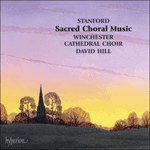 Stanford: Sacred choral music Stanford: Sacred choral musicThis three-disc set contains a generous selection of Stanford’s sacred choral music—settings for Matins, Evensong, motets, anthems and hymns—perfectly performed by Winchester Cathedral Choir at its best, conducted by David Hill.» More |
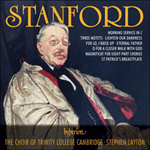 Stanford: Choral Music Stanford: Choral MusicA selection of Stanford’s finest church music in a wide-ranging programme from Trinity College Choir.» More |
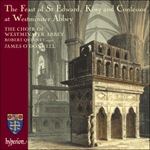 The Feast of St Edward at Westminster Abbey The Feast of St Edward at Westminster Abbey‘Anglican music can be heard at its best from Westminster Abbey … a varied programme stylishly performed’ (Choir & Organ) ‘Early notice is served of how well the Abbey's choristers are currently singing … an admirably varied programme, with excellent Hyperion recordi ...» More |
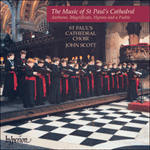 The Music of St Paul's Cathedral The Music of St Paul's Cathedral'An awe-inspiring sound' (Classic FM Magazine) 'This is a worthy Millennium tribute to the musicians of St Paul’s. A disc to treasure' (Organists' Review)» More |
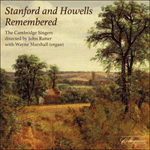 Stanford and Howells Remembered Stanford and Howells RememberedThis newly remastered version of The Cambridge Singers' 1992 Stanford and Howells album has been expanded to include almost twenty minutes of previously unreleased material, including Stanford's resplendent Latin Magnificat. John Rutter and The Ca ...» More |

